Teaching with Artificial Intelligence in Architecture: Embedding Technical Skills and Ethical Reflection in a Core Design Studio
Abstract
1. Introduction
1.1. AI in Architectural Practice
1.2. AI in Architectural Education
1.3. Educational Feedback and Pedagogical Challenges
1.4. Summary
- To develop a pedagogical framework for systematically embedding AI content into undergraduate core design studios while maintaining disciplinary coherence.
- To investigate how AI tools are applied across different stages of the design process and how student engagement varies accordingly.
- To evaluate students’ perceptions of AI in supporting creative development, managing expression, and fostering ethical awareness, based on feedback and in-studio observations.
- To identify key practical challenges and opportunities associated with AI integration.
2. Course Design and Pedagogical Framework
2.1. Context of Curriculum Reform
2.2. Overview of Architectural Design III/IV Studio
- The integration of AI technologies into architectural pedagogy remains in its nascent stage, with few established instructional models or empirically grounded precedents to guide curriculum development.
- Students predominantly rely on conventional design thinking and procedural habits, which limits their ability to engage with AI tools in a conceptually coherent and methodologically structured manner.
- Students’ understanding of AI is often fragmented and disproportionately focused on visual outputs, highlighting the urgent need for a more structured integration throughout the full design process.
2.3. Modular Integration of AI Skills and AI Ethics Components
2.4. Survey Design for Student Feedback
3. Studio Implementation and Results
3.1. AI-Integrated Design Development
3.2. AI-Integrated Visual Representation
3.3. AI-Integrated Pre-Design Research Stage
3.4. Survey Results
4. Discussions
4.1. Modular Integration Enables Scalable and Responsive Curriculum Reform
4.2. Student Engagement and the Challenge of Deep AI Integration
4.3. Embedding Ethical Thinking Through AI-Integrated Design Practice
5. Conclusions
- Modular integration is both practical and scalable: Embedding a 20 h AI skills module alongside in-class ethics discussions proved effective without altering the original studio structure, offering a replicable model for AI-integrated design education.
- A dedicated technical instructor is essential: The rapid evolution of AI tools requires real-time updates and hands-on support beyond the capacity of traditional studio instructors. Assigning a technical lead enabled the consistent, up-to-date delivery of AI instruction throughout the course cycle.
- Student engagement is phase-dependent and tool-sensitive: Survey responses indicated higher engagement during the pre-design research and design development phases. Students demonstrated relatively consistent familiarity with large language models, while their perceptions of more complex systems such as image generation tools and custom workflows varied significantly, reflecting differences in technical confidence and cognitive readiness.
- AI integration promotes both cognitive growth and ethical orientation: The pedagogical value of AI lies in strengthening students’ strategic thinking, digital adaptability, and critical design judgment while also encouraging ethical reflection on issues such as authorship, bias, accountability, and the broader implications of human–AI collaboration. Rather than treating AI as a black box generator, students are positioned to engage with it as a co-author requiring intentional guidance and responsibility.
- Supportive infrastructure underpins successful implementation: Robust institutional systems, such as e-learning platforms, cloud computing resources, and access to research-based tools including pretrained models and custom workflows, were essential to enabling meaningful experimentation and sustained technical engagement.
Supplementary Materials
Author Contributions
Funding
Institutional Review Board Statement
Informed Consent Statement
Data Availability Statement
Acknowledgments
Conflicts of Interest
Abbreviations
| AI | Artificial Intelligence |
| AIGC | Artificial Intelligence-Generated Content |
| LLM | Large Language Model |
| LoRA | Low-Rank Adaptation |
| CLIP | Collaborative Layout Integration Platform |
Appendix A
| 1. Demographical Background | ||||
| 1.1 Your name: | ||||
| 1.2 Your student no.: | ||||
| 1.3 Your gender: | ||||
| 1.4 Have you participated in the AI modules embedded in the Architectural Design Studio at Zhejiang University? | ||||
|
|
|
| |
| 1.5 Please rate the extent to which this AI module benefited your design learning: | ||||
|
|
|
|
|
| 2. Assessment of AI tool effectiveness | ||||
|
|
|
|
|
| 2.1: AI tools demonstrate strong information synthesis capabilities (e.g., organizing large volumes of input documents). | ||||
| 2.2: AI tools demonstrate strong analytical reasoning capabilities (e.g., deriving insights from input materials). | ||||
| 2.3: AI tools demonstrate strong creative thinking capabilities (e.g., generating unconventional ideas). | ||||
| 2.4: AI tools demonstrate strong visual representation capabilities (e.g., generating qualified images). | ||||
| 3. Descriptive feedback of AI-integrated teaching | ||||
| 3.1 To what extent have you used AI tools in architectural design studios? | ||||
|
|
|
| |
| 3.2 In which phases of architectural design studios have you used AI tools? (Multiple choices) | ||||
|
|
| ||
| 3.3 Rank the practicality of the following AIGC tools (1–4): (Respondents were only presented with this ranking task if they had selected the corresponding phase in question 3.2.) | ||||
| Phase | AI Tools | |||
| 3.3.1 Research |
|
|
|
|
| 3.3.2 Design |
|
|
|
|
| 3.3.3 Representation |
|
|
|
|
| 3.4 Will you consider using AI tools in future design projects? | ||||
|
|
|
|
|
| 3.5 Do you think formal teaching and classroom discussions on AI ethics are necessary? | ||||
|
|
|
| |
References
- Cocho-Bermejo, A. Artificial Intelligence and Architectural Design before Generative AI: Artificial Intelligence Algorithmics Approaches 2000–2022 in Review. Eng. Rep. 2025, 7, e70114. [Google Scholar] [CrossRef]
- Onatayo, D.; Onososen, A.; Oyediran, A.O.; Oyediran, H.; Arowoiya, V.; Onatayo, E. Generative AI Applications in Architecture, Engineering, and Construction: Trends, Implications for Practice, Education & Imperatives for Upskilling—A Review. Architecture 2024, 4, 877–902. [Google Scholar] [CrossRef]
- Leach, N. Architecture in the Age of Artificial Intelligence: An Introduction to AI for Architects; Bloomsbury Visual Arts: London, UK, 2022; ISBN 978-1-350-16555-7. [Google Scholar]
- Song, B.; Gyory, J.T.; Zhang, G.; Soria Zurita, N.F.; Stump, G.; Martin, J.; Miller, S.; Balon, C.; Yukish, M.; McComb, C.; et al. Decoding the Agility of Artificial Intelligence-Assisted Human Design Teams. Des. Stud. 2022, 79, 101094. [Google Scholar] [CrossRef]
- Yuan, F.; Xu, X.; Wang, Y. Toward an AI-augmented generative design era. Archit. J. 2023, 10, 14–20. (In Chinese) [Google Scholar] [CrossRef]
- Brunetti, G.L. Evolutionary Trends in the Use of Artificial Intelligence in Support of Architectural Design. TECHNE-J. Technol. Archit. Environ. 2023, 27, 55–60. [Google Scholar] [CrossRef]
- Wang, H.; Fu, T.; Du, Y.; Gao, W.; Huang, K.; Liu, Z.; Chandak, P.; Liu, S.; Van Katwyk, P.; Deac, A.; et al. Scientific Discovery in the Age of Artificial Intelligence. Nature 2023, 620, 47–60. [Google Scholar] [CrossRef] [PubMed]
- Başarir, L. Modelling AI in Architectural Education. Gazi Univ. J. Sci. 2022, 35, 1260–1278. [Google Scholar] [CrossRef]
- AEC Business How Data Drives the Future of Design. Available online: https://aec-business.com/how-data-drives-the-future-of-design/ (accessed on 24 June 2025).
- The Times Zaha Hadid Architects Builds ‘Winner Proposals’ with AI. Available online: https://www.thetimes.com/business-money/entrepreneurs/article/zaha-hadid-architects-builds-winner-proposals-with-ai-enterprise-network-qs7m7txwz (accessed on 24 June 2025).
- GSD. Generative AI in Teaching and Learning at the GSD; Harvard Graduate School of Design: Cambridge, MA, USA, 2024. [Google Scholar]
- GSD AI, Machine Learning, and the Built Environment—Harvard Graduate School of Design Executive Education. Available online: https://execed.gsd.harvard.edu/programs/artificial-intelligence-built-environment/?utm_source=chatgpt.com (accessed on 25 June 2025).
- GSAPP Spatial AI. Available online: https://www.arch.columbia.edu/courses/14172-4740?utm_source=chatgpt.com (accessed on 25 June 2025).
- GSAPP Ai for Existing Buildings. Available online: https://www.arch.columbia.edu/courses/13583-5674-ai-for-existing-buildings (accessed on 25 June 2025).
- TU Delft MOOC: AI in Architectural Design: Introduction|TU Delft Online. Available online: https://online-learning.tudelft.nl/courses/ai-in-architectural-design/?utm_source=chatgpt.com (accessed on 25 June 2025).
- Jin, S.; Tu, H.; Li, J.; Fang, Y.; Qu, Z.; Xu, F.; Liu, K.; Lin, Y. Enhancing Architectural Education through Artificial Intelligence: A Case Study of an AI-Assisted Architectural Programming and Design Course. Buildings 2024, 14, 1613. [Google Scholar] [CrossRef]
- Min, J.; Yu, B.; Zhang, X. Exploring design studio pedagogy in the age of generative artificial intelligence: A case study of the studio class of “Generative AI Short Film” at School of Architecture, Tsinghua university. Archit. J. 2023, 10, 42–49. (In Chinese) [Google Scholar] [CrossRef]
- Southeast University AI-Enhanced Curriculum Design: Adaptable Housing|Grade 4 Undergraduate Design Studio. Available online: https://arch.seu.edu.cn/2024/0604/c9122a492630/page.htm (accessed on 25 June 2025). (In Chinese).
- Calixto, V.; Croffi, J. Back to Black Boxes? An Urgent Call for Discussing the Impacts of the Emergent AI-Driven Tools in the Architecture Design Education. In Proceedings of the International Conference on Computer-Aided Architectural Design Research in Asia, CAADRIA 2024, Singapore, 20–26 April 2024; pp. 39–48. [Google Scholar]
- Gillani, N.; Eynon, R.; Chiabaut, C.; Finkel, K. Unpacking the “Black Box” of AI in Education. Educ. Technol. Soc. 2022, 26, 99–111. [Google Scholar]
- Abdullah, H.K.; Hassanpour, B. Digital Design Implications: A Comparative Study of Architecture Education Curriculum and Practices in Leading Architecture Firms. Int. J. Technol. Des. Educ. 2021, 31, 401–420. [Google Scholar] [CrossRef]
- Nguyen, M.; Mougenot, C. A Systematic Review of Empirical Studies on Multidisciplinary Design Collaboration: Findings, Methods, and Challenges. Des. Stud. 2022, 81, 101120. [Google Scholar] [CrossRef]
- Zawacki-Richter, O.; Marín, V.I.; Bond, M.; Gouverneur, F. Systematic Review of Research on Artificial Intelligence Applications in Higher Education—Where Are the Educators? Int. J. Educ. Technol. High. Educ. 2019, 16, 39. [Google Scholar] [CrossRef]
- Baidoo-Anu, D.; Asamoah, D.; Amoako, I.; Mahama, I. Exploring Student Perspectives on Generative Artificial Intelligence in Higher Education Learning. Discov. Educ. 2024, 3, 98. [Google Scholar] [CrossRef]
- Jiang, Q.; Zhang, Y.; Wei, W.; Gu, C. Evaluating Technological and Instructional Factors Influencing the Acceptance of AIGC-Assisted Design Courses. Comput. Educ. Artif. Intell. 2024, 7, 100287. [Google Scholar] [CrossRef]
- Komatina, D.; Miletić, M.; Mosurović Ružičić, M. Embracing Artificial Intelligence (AI) in Architectural Education: A Step towards Sustainable Practice? Buildings 2024, 14, 2578. [Google Scholar] [CrossRef]
- Rao, J.; Xiong, M. Research on Environmental Architectural Design Methods Based on the AIGC Creation Method. In Frontiers in Artificial Intelligence and Applications; Ying, F., Jain, L.C., Wan, R., Wu, Q., Shi, F., Eds.; IOS Press: Amsterdam, The Netherlands, 2024; ISBN 978-1-64368-506-9. [Google Scholar]
- Salhab, R. AI Literacy across Curriculum Design: Investigating College Instructor’s Perspectives. Online Learn. 2024, 28, n2. [Google Scholar] [CrossRef]
- Checketts, L.; Chan, B.S.B. (Eds.) Social and Ethical Considerations of AI in East Asia and Beyond; Philosophy of Engineering and Technology; Springer Nature: Cham, Switzerland, 2024; ISBN 978-3-031-77856-8. [Google Scholar]
- Peters, M.A.; Jackson, L.; Papastephanou, M.; Jandrić, P.; Lazaroiu, G.; Evers, C.W.; Cope, B.; Kalantzis, M.; Araya, D.; Tesar, M.; et al. AI and the Future of Humanity: ChatGPT-4, Philosophy and Education—Critical Responses. Educ. Philos. Theory 2024, 56, 828–862. [Google Scholar] [CrossRef]
- Wu, Y.; Xu, W.; Meng, H. From chain to ecology—The reform of the digital course system in the Department of Architecture of Zhejiang University. J. Archit. Educ. Inst. High. Learn. 2024, 33, 67–75. (In Chinese) [Google Scholar]
- Chen, X.; Jiang, X.; Li, X. Preliminary study of problem-oriented teaching of architectural design—Analysis of core design course system of architecture undergraduate course in ZJU. China Archit. Educ. 2019, 69–77. (In Chinese) [Google Scholar]
- Thampanichwat, C.; Wongvorachan, T.; Sirisakdi, L.; Chunhajinda, P.; Bunyarittikit, S.; Wongmahasiri, R. Mindful Architecture from Text-to-Image AI Perspectives: A Case Study of DALL-E, Midjourney, and Stable Diffusion. Buildings 2025, 15, 972. [Google Scholar] [CrossRef]
- Schiff, D. Out of the Laboratory and into the Classroom: The Future of Artificial Intelligence in Education. AI Soc. 2021, 36, 331–348. [Google Scholar] [CrossRef]
- Formosa, D. Design Education Is Too Important to Be Left to Designers. Des. Stud. 2025, 98, 101301. [Google Scholar] [CrossRef]
- Hullman, J.; Holtzman, A.; Gelman, A. Artificial Intelligence and Aesthetic Judgment. arXiv 2023. [Google Scholar] [CrossRef]
- Cheng, K.; Wu, C. Transcending the form: Modeling AIGC-involved imagery guidelines. Archit. J. 2025, 1, 20–27. (In Chinese) [Google Scholar] [CrossRef]
- Valentine, C.; Wilkins, A.J.; Mitcheltree, H.; Penacchio, O.; Beckles, B.; Hosking, I. Visual Discomfort in the Built Environment: Leveraging Generative AI and Computational Analysis to Evaluate Predicted Visual Stress in Architectural Façades. Buildings 2025, 15, 2208. [Google Scholar] [CrossRef]
- Floridi, L.; Chiriatti, M. GPT-3: Its Nature, Scope, Limits, and Consequences. Minds Mach. 2020, 30, 681–694. [Google Scholar] [CrossRef]
- Lo, C.K. What Is the Impact of ChatGPT on Education? A Rapid Review of the Literature. Educ. Sci. 2023, 13, 410. [Google Scholar] [CrossRef]
- Yuan, J.; Wu, F. The shift in knowledge production logic in the era of artificial intelligence and educational responses. Chin. J. Distance Educ. 2025, 45, 20–34. (In Chinese) [Google Scholar] [CrossRef]
- McIntosh, T.R.; Susnjak, T.; Liu, T.; Watters, P.; Xu, D.; Liu, D.; Nowrozy, R.; Halgamuge, M.N. From COBIT to ISO 42001: Evaluating Cybersecurity Frameworks for Opportunities, Risks, and Regulatory Compliance in Commercializing Large Language Models. Comput. Secur. 2024, 144, 103964. [Google Scholar] [CrossRef]
- Mügge, D. EU AI Sovereignty: For Whom, to What End, and to Whose Benefit? J. Eur. Public Policy 2024, 31, 2200–2225. [Google Scholar] [CrossRef]
- Tuzov, V.; Lin, F. Two Paths of Balancing Technology and Ethics: A Comparative Study on AI Governance in China and Germany. Telecommun. Policy 2024, 48, 102850. [Google Scholar] [CrossRef]



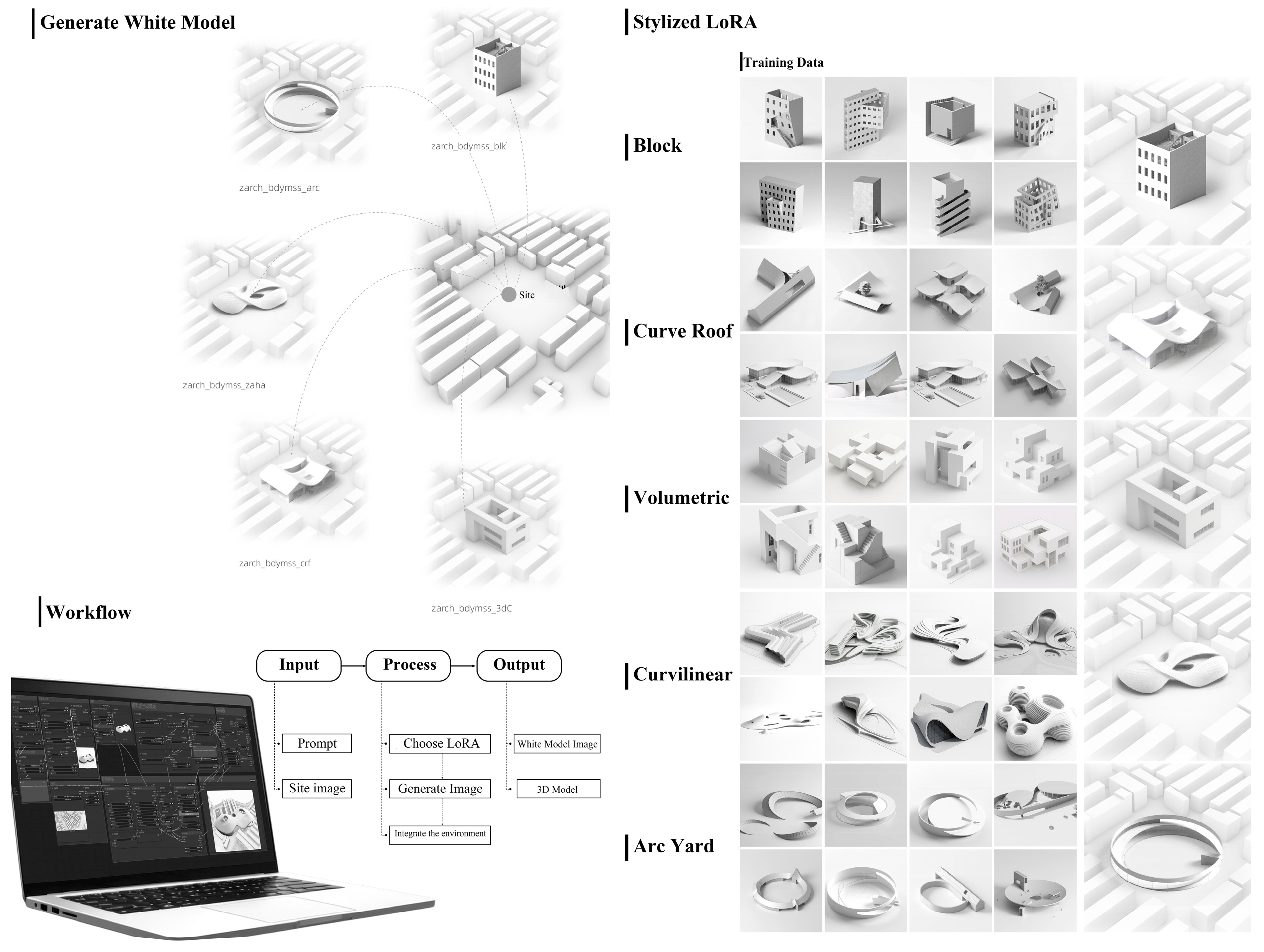

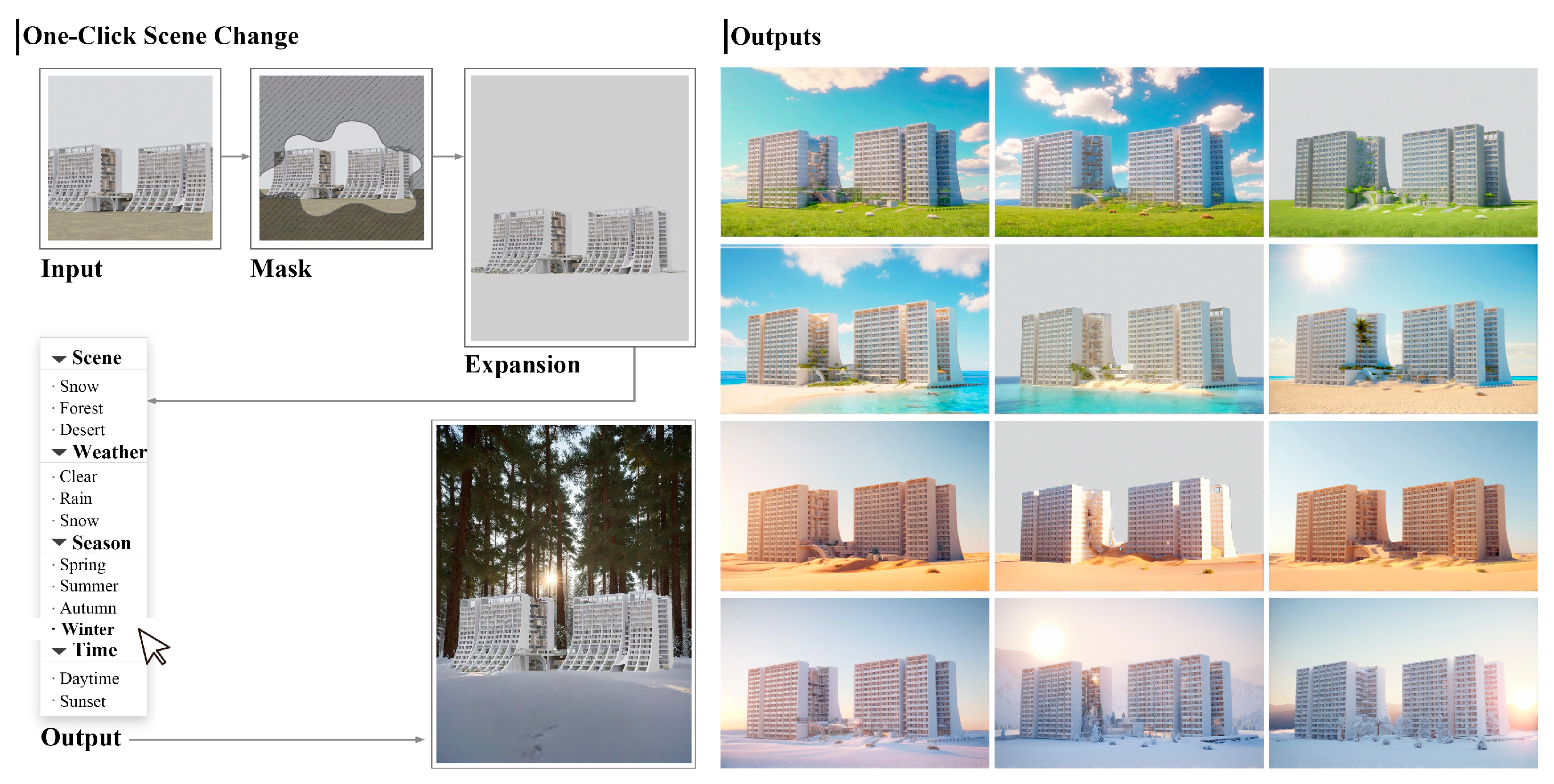
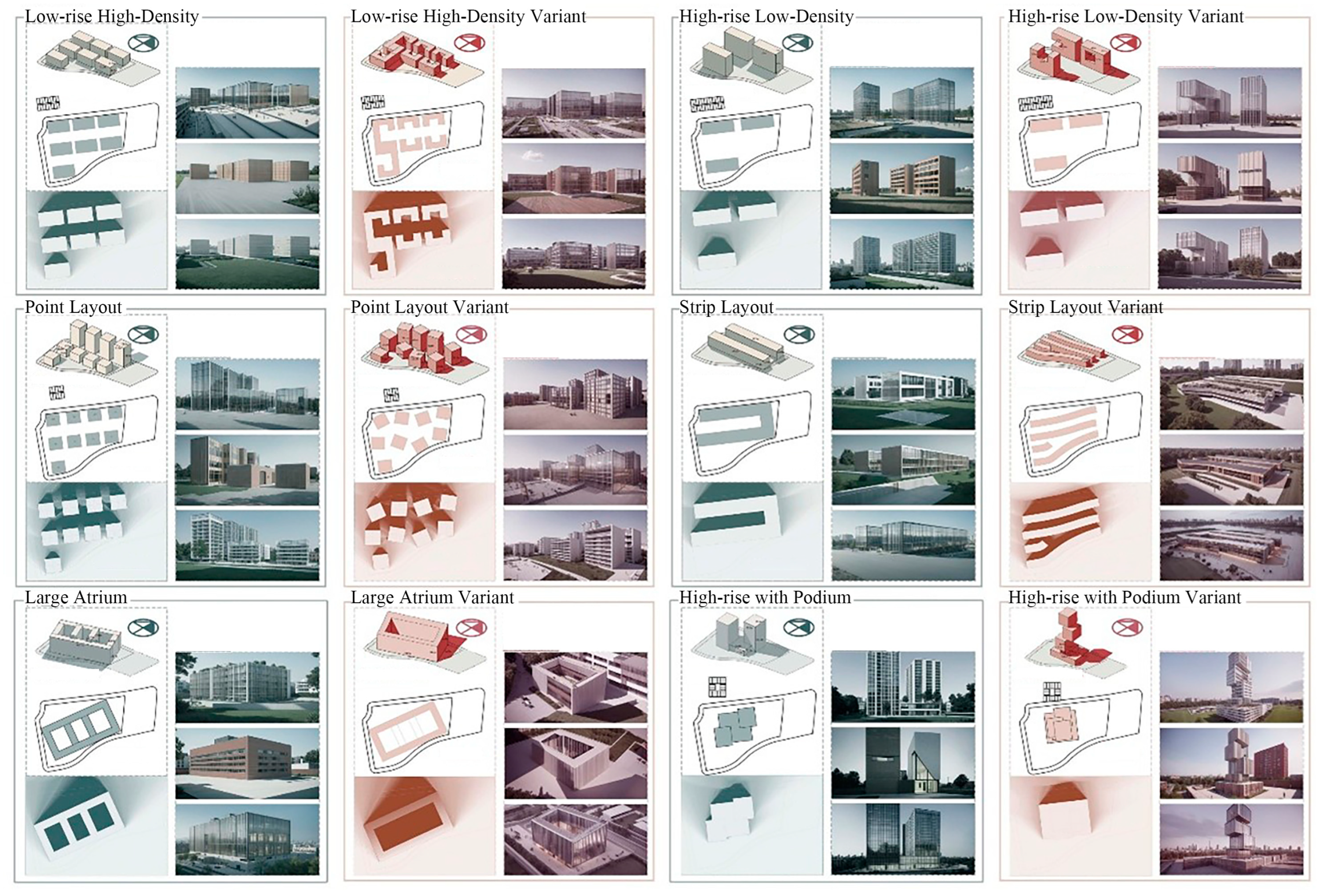
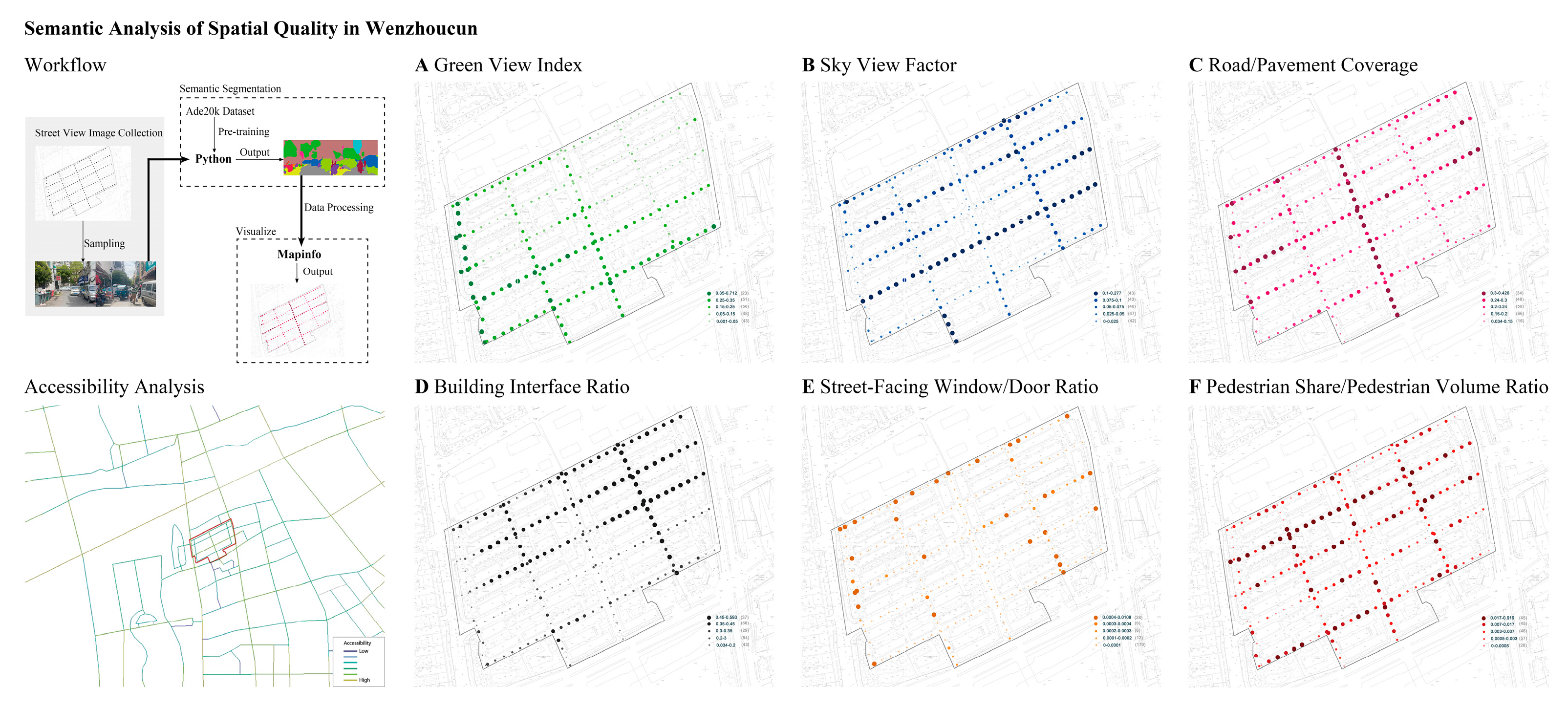
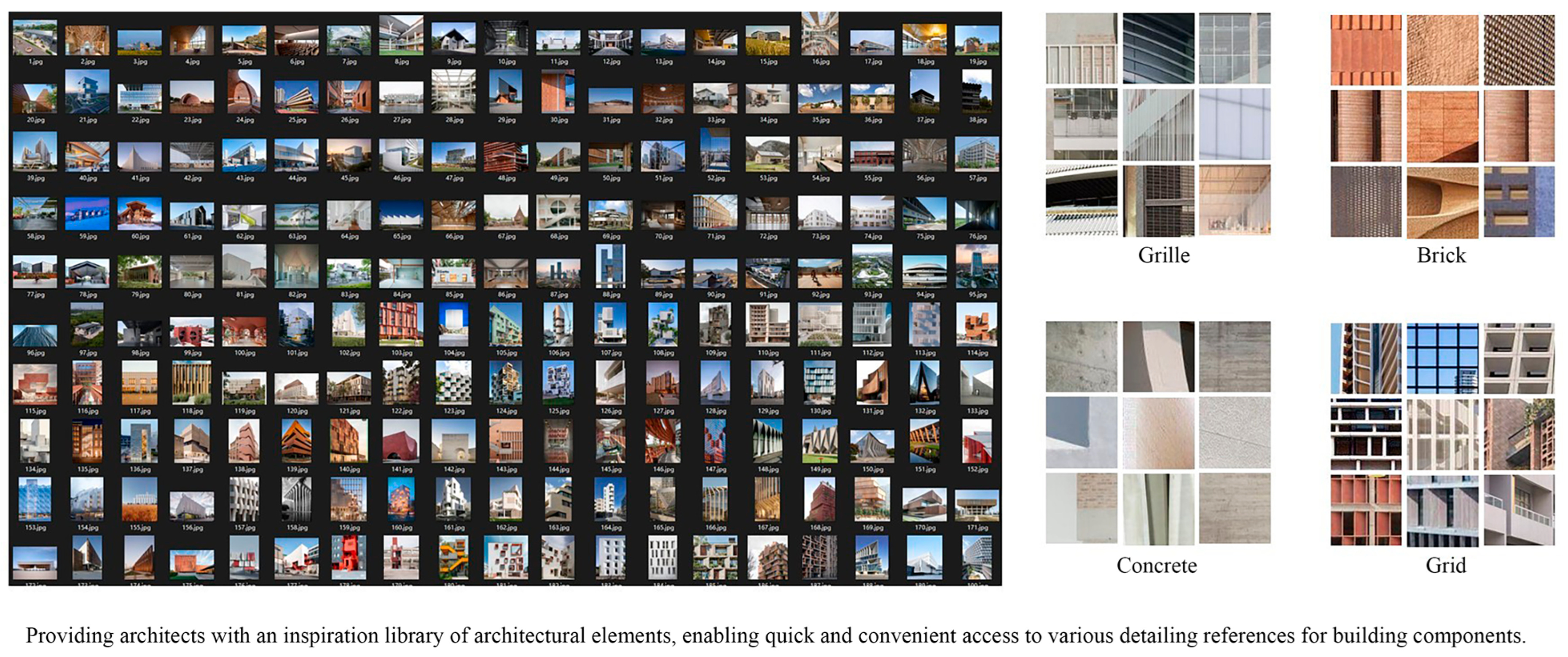
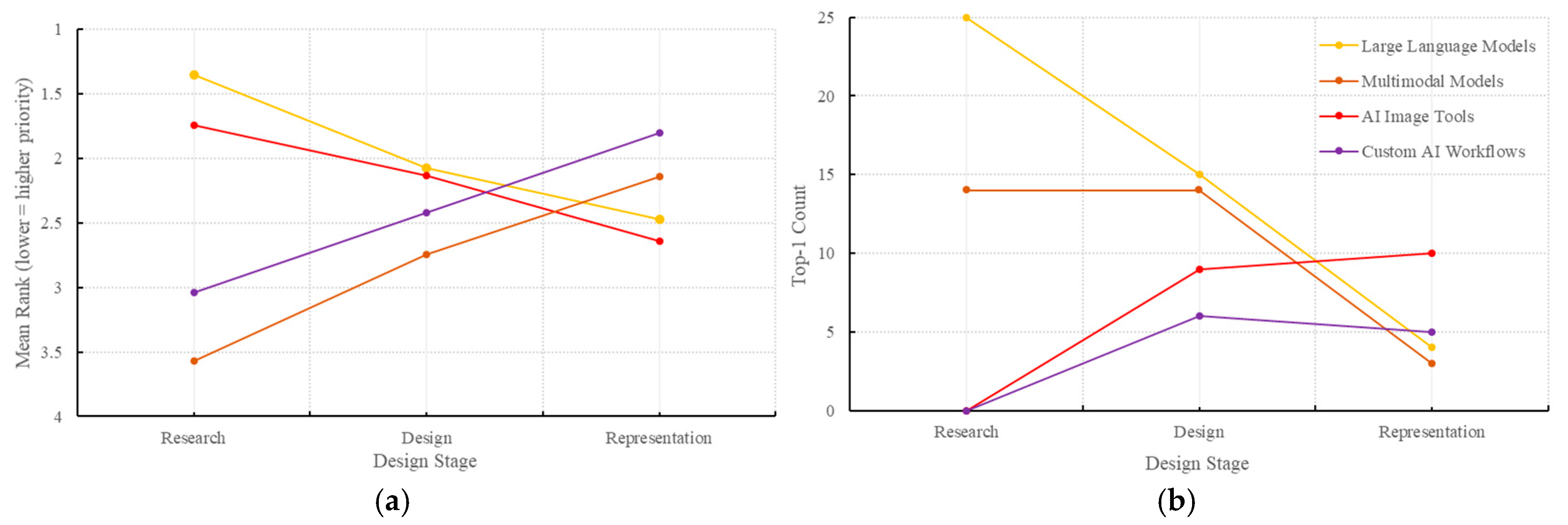
| Week | Class-Hours 1 | Design Task | AI Ethics Module | AI Skills Module 2 |
|---|---|---|---|---|
| Fall 1–8 | 64 | Architecture & Re-build | Ethic Ⅰ: Data Privacy and Copyright | Skill Ⅰ (2 class-hours): Foundations of AI |
| Skill Ⅱ (4 class-hours): Prompt Engineering and Image Generation | ||||
| Fall 9–16 | 64 | System & Synthesis | Ethic Ⅱ: Accountability in Human–AI Collaboration | Skill Ⅲ (4 class-hours): LoRA Model Training and Fine-tuning |
| Skill Ⅳ-1 (3 class-hours): ComfyUI Workflow—Basics | ||||
| Summer 1–4 | 32 | X & Hypothesis | Ethic Ⅲ: Stylistic Authorship and Cultural Bias | Skill Ⅳ-2 (3 class-hours): ComfyUI Workflow—Advanced |
| Summer 5–16 | 96 | Urban & Renewal | Ethic Ⅳ: Model Bias | Skill Ⅴ (4 class-hours): Multimodal Integration |
| Category | Option | n | Percentage (%) |
|---|---|---|---|
| Gender | Male | 38 | 54.3% |
| Female | 32 | 45.7% | |
| Participation in AI-integrated Coursework | Attended lectures only | 17 | 24.3% |
| Attended lectures and took exercises | 32 | 45.7% | |
| Practiced exercises and applied AI tools in design studio | 21 | 30.0% | |
| Perceived Benefit | 1: Not beneficial at all | 1 | 1.4% |
| 2: Slightly beneficial | 2 | 2.9% | |
| 3: Moderately beneficial | 25 | 35.7% | |
| 4: Very beneficial | 25 | 35.7% | |
| 5: Extremely beneficial | 17 | 24.3% | |
| Overall AI Tool Usage in Architectural Design Studios | 1: Never used | 14 | 13.7% |
| 2: Briefly experimented | 52 | 51.0% | |
| 3: Used multiple times for process discussions | 30 | 29.4% | |
| 4: Frequently used for multiple tasks | 6 | 5.9% |
| Question | Mean (M) | Standard Deviation (SD) | Percentage Agree (4–5) |
|---|---|---|---|
| AI tools demonstrate strong information synthesis capabilities | 4.28 | 0.84 | 84.1% |
| AI tools demonstrate strong analytical reasoning capabilities | 3.86 | 0.94 | 67.1% |
| AI tools demonstrate strong creative thinking capabilities | 3.46 | 1.02 | 44.3% |
| AI tools demonstrate strong visual representation capabilities | 3.47 | 1.03 | 44.3% |
| Design Stage | n | Percentage (%) |
|---|---|---|
| Pre-design Research | 39 | 55.7 |
| Design Development | 44 | 62.9 |
| Final Representation | 22 | 31.4 |
| Tool Type | Mean Rank (Research) | Top-1 Count (Research) | Mean Rank (Design) | Top-1 Count (Design) | Mean Rank (Representation) | Top-1 Count (Representation) |
|---|---|---|---|---|---|---|
| Large Language Models | 1.35 | 25 | 2.07 | 15 | 2.47 | 4 |
| Multimodal Models | 1.74 | 14 | 2.16 | 14 | 2.64 | 3 |
| AIGC Image Tools | 3.04 | 0 | 2.41 | 9 | 1.80 | 10 |
| Custom AI Workflows | 3.59 | 0 | 2.82 | 6 | 2.14 | 5 |
| Category | Option | n | Percentage (%) |
|---|---|---|---|
| Future Use of AI Tools | Yes, I am very interested and plan to increase my use | 18 | 25.7% |
| Yes, but I believe current tools are not yet mature and I will observe how they evolve | 40 | 57.1% | |
| Not for now, but I will stay informed | 10 | 14.3% | |
| No, I do not plan to use them due to high technical barriers | 1 | 1.4% | |
| No, I do not find AI tools relevant or useful | 1 | 1.4% | |
| AI Ethics Teaching Attitude | Yes, formal teaching and structured classroom discussions are necessary | 20 | 28.6% |
| Somewhat necessary, but informal discussion or self-reflection may be sufficient | 46 | 65.7% | |
| Not necessary | 4 | 5.7% | |
| No opinion or not sure | 0 | 0 |
Disclaimer/Publisher’s Note: The statements, opinions and data contained in all publications are solely those of the individual author(s) and contributor(s) and not of MDPI and/or the editor(s). MDPI and/or the editor(s) disclaim responsibility for any injury to people or property resulting from any ideas, methods, instructions or products referred to in the content. |
© 2025 by the authors. Licensee MDPI, Basel, Switzerland. This article is an open access article distributed under the terms and conditions of the Creative Commons Attribution (CC BY) license (https://creativecommons.org/licenses/by/4.0/).
Share and Cite
Wang, J.; Shi, Y.; Chen, X.; Lan, Y.; Liu, S. Teaching with Artificial Intelligence in Architecture: Embedding Technical Skills and Ethical Reflection in a Core Design Studio. Buildings 2025, 15, 3069. https://doi.org/10.3390/buildings15173069
Wang J, Shi Y, Chen X, Lan Y, Liu S. Teaching with Artificial Intelligence in Architecture: Embedding Technical Skills and Ethical Reflection in a Core Design Studio. Buildings. 2025; 15(17):3069. https://doi.org/10.3390/buildings15173069
Chicago/Turabian StyleWang, Jiaqi, Yu Shi, Xiang Chen, Yi Lan, and Shuying Liu. 2025. "Teaching with Artificial Intelligence in Architecture: Embedding Technical Skills and Ethical Reflection in a Core Design Studio" Buildings 15, no. 17: 3069. https://doi.org/10.3390/buildings15173069
APA StyleWang, J., Shi, Y., Chen, X., Lan, Y., & Liu, S. (2025). Teaching with Artificial Intelligence in Architecture: Embedding Technical Skills and Ethical Reflection in a Core Design Studio. Buildings, 15(17), 3069. https://doi.org/10.3390/buildings15173069








